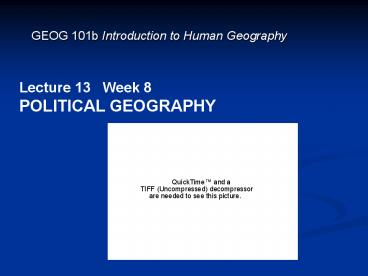GEOG 101b Introduction to Human Geography PowerPoint PPT Presentation
1 / 27
Title: GEOG 101b Introduction to Human Geography
1
GEOG 101b Introduction to Human Geography
Lecture 13 Week 8 POLITICAL GEOGRAPHY
2
Contents
- Introduction to Political Geography
- Political ordering of space
- Boundaries
- Geopolitics and distribution of power
3
1. Introduction to Political Geography
- Political Geography focuses on
- Boundaries
- Political power
- Expansionism, Imperialism
- International alliances, regional cartels, etc.
4
Political Geography
- How and why states are organized into regional
groupings, - Formally (e.g. the European Union) and
- informally (e.g. the Third World)
- The relationship between states and former
colonies, and how these are propagated over time
through neo-colonialism - The relationship between a government and its
people
5
Political Geography
- The relationships between states including
international trades and treaties - The functions, demarcations and policings of
boundaries - How imagined geographies have political
implications - The influence of political power on geographical
space - The study of election results (election geography)
6
Political Geography
- Definition
- The study of the organization/distribution of
political phenomena and their impact on other
spatial components of society and culture
7
Definitions
- State country
- Territory area controlled by a state
- Nation cultural group
- people with a common ancestry, culture, language,
religion, history - Nation state clearly defined cultural group (a
nation) occupying a spatially defined territory
(a state)
8
2. Political ordering of space
- Friedrich Ratzel
- Founder of modern Political Geography
- The states operate cyclically and organically
- States consolidate and fragment based on complex
relationships among and between factors
18441904 German geographer
9
(No Transcript)
10
Geographic characteristics of states
- Geographic characteristics of states and state
boundaries are intertwined - Size
- Shape
- Location
- These characteristics affect the power and
stability of states
11
Size
- Larger states
- Often have a large amount of resources
- Can have a widely distributed population
- More likely to have a heterogeneous population
- Smaller states
- Often have a culturally homogeneous population
- Short boundaries facilitates defense the
development of transport/communication systems
12
Colonialism and the formation of new states
- Colonialism involves the formal establishment
and maintenance of rule by a sovereign power over
a foreign population - Establishment of settlements
- It is an adjunct to the colonial power
- Resources exploitation
13
- Boundaries delimit the political organization of
space people
14
3. Boundaries
- Boundaries are
- Lines that establish the limit of each
jurisdiction authority - Jurisdiction administers laws collects taxes
provides defense, education, training enforces
legal code, etc. - 3-dimensional flat, deep, high
15
Political Boundaries
- Political boundaries represent the spatial limit
of the political organization of territory - They exist at different scales
- Supra-national-scale organizations, such as UN
- State-scale
- Intra-state scale boundaries used for the many
sub-divisions of territory within the state
16
- May be a source of friction between competing
political entities (flashpoints) - May serve as peaceful reminders of contrasting
but accepted differences
17
Boundary Types
- 1. Geometric boundary
- Straight lines based on
- lines of latitude/longitude or drawn from fixed
points totally unrelated to any aspects of the
cultural/physical landscape
18
- 2. Physiographic (physical/natural) boundary
- Based on recognizable physiographic features
- mountains
- rivers/water bodies
19
- 3. Anthropomorphic (cultural) boundary
- Mark breaks in the human landscape
- Reflects the extent of ethnic and national
identities - often according to language, religion or
ethnology - cultural breaks in the human landscape tend to
shift over time - often lead to conflict
20
Boundaries state cohesiveness
- Centripetal forces
- A clearly bounded territory promotes
unity/national stability - Centrifugal forces
- The more boundaries possessed by a state, the
greater is the likelihood of conflict which
disrupts unity/national stability
21
- Possible centrifugal forces
- internal divisions in language, religion
- lack of a long history in common
- state boundaries that are subject to dispute
- Possible centripetal forces
- clear and well accepted state identity
- long state history
- boundaries that are clearly delimited and
well-accepted
22
Disputes for regional autonomy
- Separatism or autonomous nationalism
- Canadas secessionist movement in Quebec 1995
referendum 49 yes, 51 no. - Other separatist movements
- Basques in Spain
- Bretons in France,
- Palestinians in Israel,
- Sikhs in India, etc.
23
Electoral Geography
- Boundary issues
- Gerrymandering spatial reorganisation designed
to favour a particular party
24
4. Geopolitics and distribution of power
- Geopolitics
- Branch of political geography that considers the
strategic value of land and sea area in the
context of national economic and military power
and ambitions.
25
Views on global distribution of power
- Heartland theory (Halford Mackinder 1861-1947)
- Who rules East Europe commands the Heartland
- Who rules the Heartland commands the World Island
- Who rules the World Island commands the World
(Mackinder 1919)
26
continuation...
- Location and physical environment were key
variables in any explanation of world power
distribution - Strong environmental deterministic view
- Reflected British concerns about perceived
Russian threats to British colonies in Asia
(specially India)
27
Review
- State, Nation and Nation State
- Colonialism and the formation of new states
- Boundaries
- Geopolitics and political power
- Stability of states

